Small Batch Tomato Sauce for Canning
This post may contain affiliate links, which means that I may receive a commission if you make a purchase using these links. As an Amazon Associate I earn from qualifying purchases.
Preserve a small harvest of ripe tomatoes with this easy small batch tomato sauce for canning. A simple, unseasoned recipe that’s perfect for beginners and endlessly versatile.
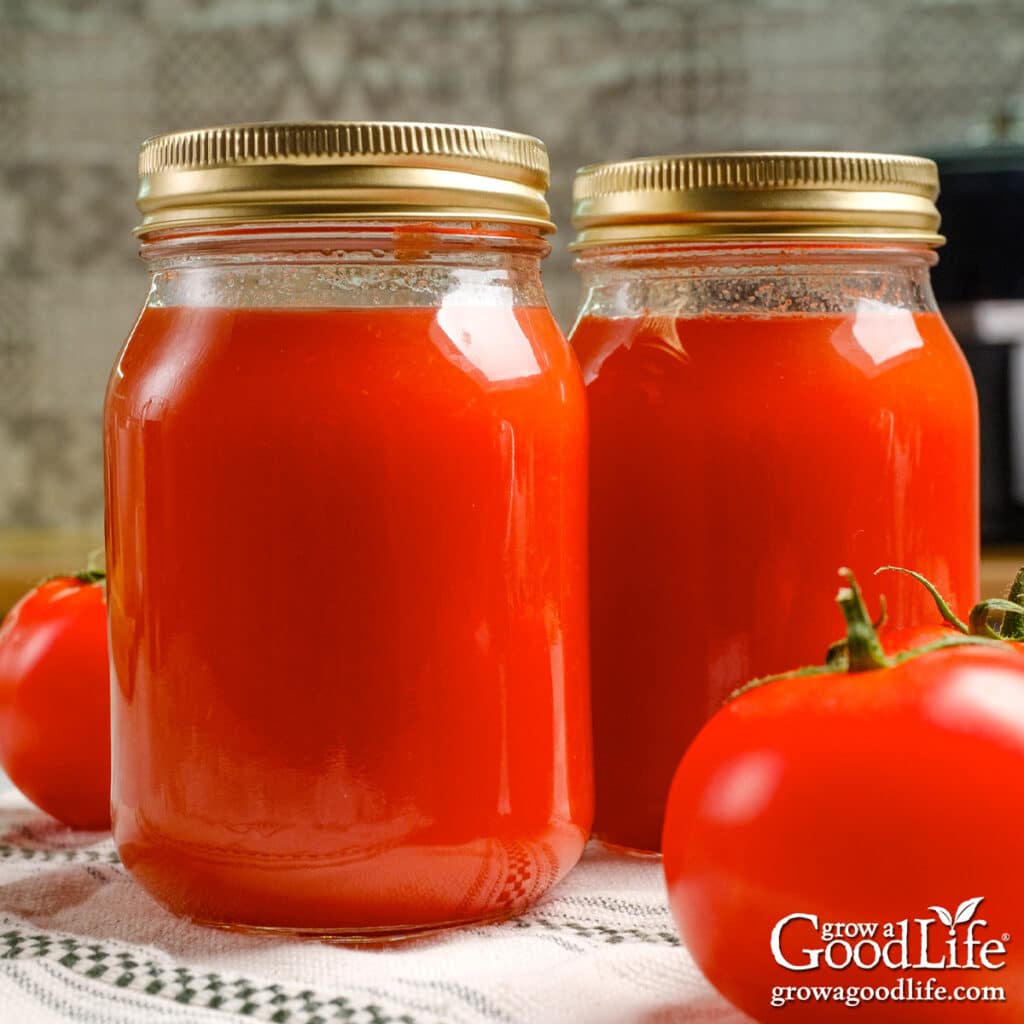
If you’re looking for a simple and reliable way to preserve a small harvest of ripe tomatoes, this small batch tomato sauce for canning is the perfect solution. Made with just fresh tomatoes and bottled lemon juice, it’s a classic, plain tomato sauce that captures the fresh flavor of the garden in every jar.
This recipe yields about four pints of smooth, unseasoned tomato sauce. Just the right amount for a smaller canning session. It’s a great choice for beginning canners or anyone who wants to make the most of a modest tomato harvest without spending an entire day in the kitchen.
Because this sauce is plain, you can season it later to match any meal, from hearty pasta dinners to homemade pizza, soups, or stews. It’s one of the most versatile canning recipes you can add to your pantry shelves.
Why You’ll Love This Recipe
Having jars of plain, unseasoned tomato sauce on your pantry shelf is one of the best ways to preserve the tomatoes from your garden. This simple, small-batch recipe creates a smooth, rich sauce that’s ready to use in countless ways.
- Customizable Flavor: Since the sauce is unseasoned, you have complete control over the flavors in your dishes. Add herbs, spices, or vegetables later to suit your recipe, whether you’re making a bold arrabbiata, a cozy tomato-basil soup, or a hearty chili.
- Perfect for Small Harvests: This small batch canning recipe is ideal when you don’t have enough tomatoes for a full canner load. It’s just the right size for preserving a few pounds of garden-ripe tomatoes.
- Time-Saving: Having jars of tomato sauce on hand significantly cuts down on meal prep time. Instead of starting from scratch with fresh tomatoes, you can open a jar and get cooking. This is especially handy for busy weeknights when time is of the essence.
- Healthier Option: Home-canned tomato sauce means you know exactly what’s inside. You won’t have to worry about preservatives, added sugars, or artificial ingredients.
- Convenience Year-Round: With jars of tomato sauce in your pantry, you’ll always have a base for quick pasta meals, homemade pizza, soups, and stews.
Ingredients You’ll Need
This small batch tomato sauce for canning uses only a few basic ingredients and yields about 3 to 4 pint jars, depending on how much you reduce the sauce.
Ripe Tomatoes
Any type of tomato will work, including paste, slicing, heirloom, or even cherry tomatoes. You’ll need about 10 to 15 pounds of tomatoes. Paste varieties, such as Roma or San Marzano, produce a thicker sauce with less simmering, while juicier tomatoes will require more time to cook down.
Choose firm, good-quality tomatoes with no signs of disease. Avoid canning tomatoes from dead or frost-killed vines, as the pH levels may change, making them unsafe for home canning.
Bottled Lemon Juice or Citric Acid (required for safety)
Tomatoes vary naturally in acidity, so acidifying each jar ensures your sauce is safe for water bath canning. Add bottled lemon juice or citric acid, as described in the recipe, to adjust the pH and prevent botulism and other bacterial concerns.
Do not use freshly squeezed lemon juice. Bottled lemon juice is standardized and contains the consistent acidity required for safe canning.
Safe Adjustments
While canning recipes must follow tested guidelines to ensure safety, you can make a few small changes to this plain tomato sauce recipe without affecting processing time or acidity.
- Choose Your Tomato Varieties: Mixing different types of tomatoes is fine. Paste tomatoes produce a dense sauce, while juicy slicing or heirloom varieties add bright, fresh flavor.
- Add Salt or Herbs: You can safely add up to 1/2 teaspoon of salt or dried herbs per pint jar (1 teaspoon per quart) for flavor. Popular options include oregano, basil, or Italian seasoning.
- Add Fresh Basil: It’s safe to include up to 1 small sprig of fresh basil per pint jar (2 small sprigs per quart). Be sure to rinse the leaves well and use only clean, unblemished basil.
- Adjust Texture: You can simmer the sauce longer to thicken or keep it looser for recipes that call for a lighter tomato base. Reducing the sauce by half creates a thicker consistency; reducing it by one-third keeps it thinner.
These adjustments let you personalize your sauce while staying within safe, research-tested guidelines for home canning.
For more ideas on safe substitutions, see: How to Safely Modify Tomato Canning Recipes.
Steps for Making and Canning Tomato Sauce
This is a standard tomato sauce canning recipe adapted from trusted, research-tested sources, including the Ball Blue Book Guide to Preserving and the Ball Mason Jars website.
If you’re new to home canning, it may be helpful to review the basics before you begin: Water Bath Canning for Beginners.
To stay organized during your canning session, download my free Home Canning Checklist. It includes a step-by-step guide through the entire canning process and a log sheet to record each batch you preserve. Get the checklist here:
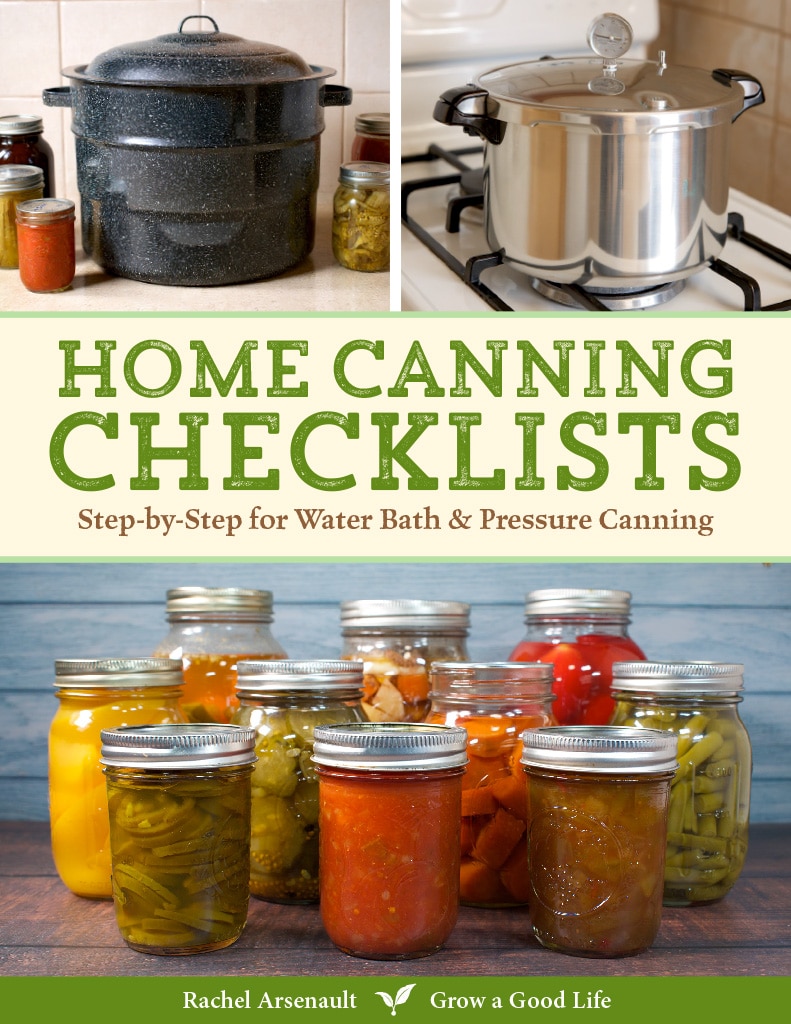
Grab your Free copy
Home Canning Checklists
You’ll find the complete, printable recipe at the bottom of this article, but here’s an overview of the detailed steps for making and canning plain tomato sauce safely at home:
Step 1: Gather Your Kitchen and Canning Equipment
Before you begin, take a few minutes to organize your workspace and gather everything you’ll need. Having your equipment ready will make the canning process smoother and help prevent mistakes once you start filling jars.
You will need:
- Water bath canner with a canning rack, or a deep stockpot tall enough to cover the jars by at least 2 inches of water.
- Canning jars: 8 half-pint sized jars, 4 pint sized canning jars, or or 2 quart-sized jars.
- Canning lids and ring bands (new lids for each jar, bands can be reused).
- Canning tools: Jar lifter, canning funnel, and bubble popper/headspace tool.
- Large ladle to fill the jars
- Plus basic kitchen supplies such as a knife, cutting board, large pot, large prep bowl, measuring spoons, ladle, and clean kitchen towels.
Tip: Use a Large Pot as a Water Bath Canner
A large water bath canner isn’t necessary for this small batch canning recipe. Instead, you can use a large pot and a small cooling rack to serve as your boiling water bath.
Ensure the pot has a lid, is tall enough to cover the tops of the jars with a few inches of water, plus an additional two inches to prevent boiling water from splashing out. Place the rack in the bottom to elevate the jars and allow water to circulate during processing.
Step 2: Prepare the Tomatoes
Begin by rinsing the tomatoes well under clean, running water. Spread them on a towel to air-dry.
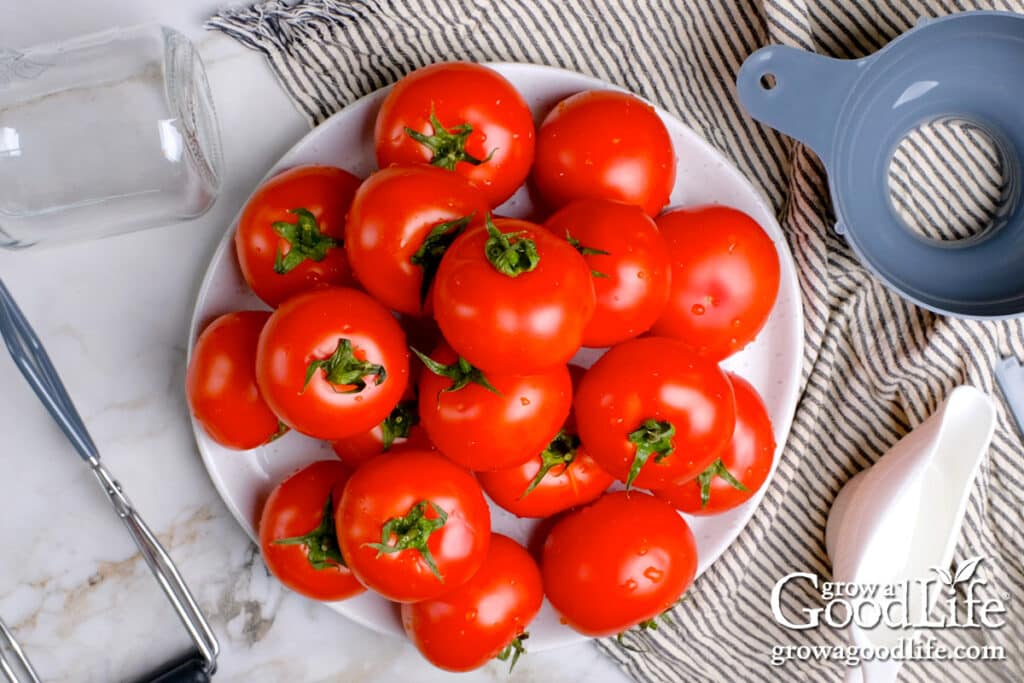
Remove Skins and Seeds
Before canning, it’s important to remove the tomato skins and seeds. The peels can harbor bacteria and add an unpleasant texture to the sauce, and both skins and seeds can affect the sauce’s thickness and prevent proper heat penetration during processing.
You can accomplish this in one of two ways:
Option 1: Using a Food Strainer or Food Mill: Cook the tomatoes briefly to soften them, then run them through a Victorio food strainer or food mill. This method easily removes the skins and seeds while creating a smooth purée, perfect for sauce. If you use this method, skip to the “Thicken the Sauce” section below.
Option 2: Without a Strainer (Blanch and Peel Method): If you don’t have a food strainer or food mill, you can use the blanching method. Refer to “How to Peel Tomatoes” for a detailed, step-by-step tutorial.
- Prepare the Tomatoes: Remove the stems and cut a shallow “X” in the bottom of each fruit.
- Blanch the Tomatoes: Bring a large saucepan of water to a boil over high heat. As the water is heating, fill a large bowl with ice water. Once the water boils, dip the tomatoes into the boiling water until the skins crack and loosen, about 30 to 60 seconds. Transfer the tomatoes from the boiling water to the bowl of ice water to cool. Repeat for all the tomatoes.
- Peel and Seed the Tomatoes: Once the tomatoes are cool enough to handle, remove the skins, scoop out the seeds, and cut out any thick cores. To remove the seeds, slice the tomato in half, hold each half over a bowl, and squeeze or scoop out the seeds with a spoon.
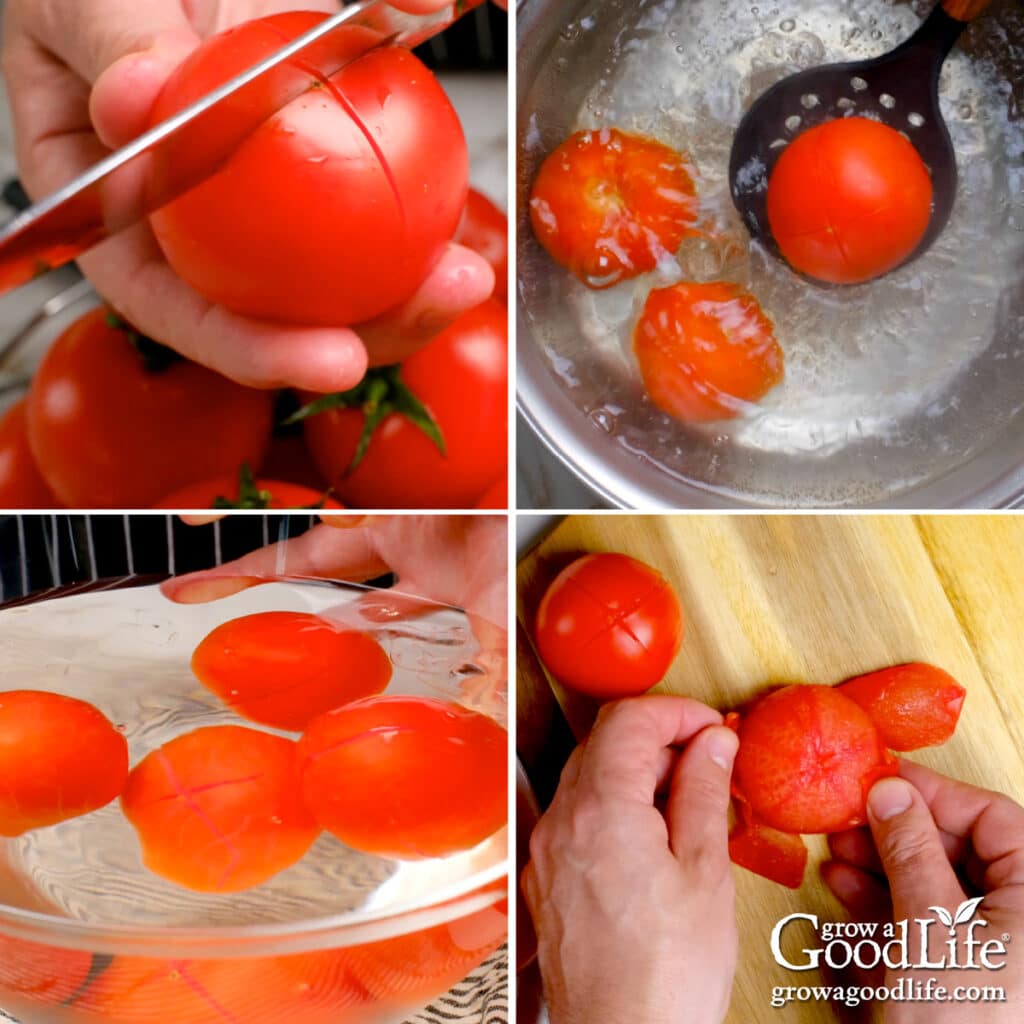
Step 3: Make the Sauce
Cook the Tomatoes: To help prevent the tomato juice from separating, cut about 6 tomatoes into quarters and place them in a large sauce pot. Bring to a boil over medium-high heat. Stir to prevent sticking and crush the tomatoes with the back of your spoon once they soften. Cut the remaining tomatoes in half and add them to the pot as you work. Stir frequently to cook evenly and prevent sticking.
Simmer and Soften: After adding all the tomatoes, continue to cook, stirring occasionally, until the tomatoes are soft and juicy, about 10 minutes.
Puree the Tomatoes: Remove the pot from the heat and let the tomatoes cool slightly, then use a food processor, blender, food mill, or sieve to smooth the sauce.
Thicken the Sauce: Return the tomato puree to the saucepot and simmer uncovered over medium-low heat until the sauce thickens and reduces in volume, about 1 to 2 hours. Reduce by 1/3 for a thin sauce or 1/2 for a thick sauce. Stir occasionally to prevent scorching and promote even cooking.

Step 4: Prepare the Canner and Jars
Wash the Equipment: While the tomato sauce is cooking, wash the jars, lids, bands, and canning tools in warm, soapy water. Rinse thoroughly and set aside to air dry on a clean kitchen towel.
Heat the Jars: Place the large pot or water bath canner on the stove. Place the jar rack into the pot, set the jars in the canner, and fill with enough water to cover the jars. Bring to a simmer (180˚F) for 10 minutes, and keep warm. Keeping jars hot helps prevent breakage when filling with hot tomato sauce.
Step 5: Fill the Jars
When the tomato sauce has thickened to your liking and your jars are hot and ready, it’s time to fill them for canning.
Prepare Your Workspace: Spread a clean kitchen towel on the counter near your canner. Keep your canning funnel, ladle, bubble popper, and measuring spoons within easy reach. Place the bottled lemon juice or citric acid nearby. You’ll add this to each jar before filling to ensure safe acidity levels.
Remove One Jar: Spread a kitchen towel on the counter. Use the jar lifter to remove one jar from the canner, draining the water back into the canner. Place the jar on the towel, keeping the remaining jars in the canner so they stay warm.
Add Acid and Sauce: Add one of the following to each empty jar before filling:
- Half-pint jar: Add 1/8 teaspoon citric acid or 1/2 tablespoon bottled lemon juice
- Pint jar: Add 1/4 teaspoon citric acid or 1 tablespoon bottled lemon juice
- Quart jar: Add 1/2 teaspoon citric acid or 2 tablespoons bottled lemon juice
Fill the Jars with Sauce: Place the canning funnel on the jar and ladle hot tomato sauce into it, leaving 1/2 inch headspace at the top.
Remove Air Bubbles: Run the bubble popper through the jar slowly to release any air bubbles. Wipe the rim with a clean, damp towel to remove any residue.
Apply the Lid and Band: Add the lid and secure it with a screw band until it is fingertip tight. Return the jar to the canner. Repeat with the rest of the jars.
Tip: If you find you have a partial jar that isn’t full enough for canning, refrigerate it instead of processing it. Use it within a few days for pasta, soup, or pizza night.
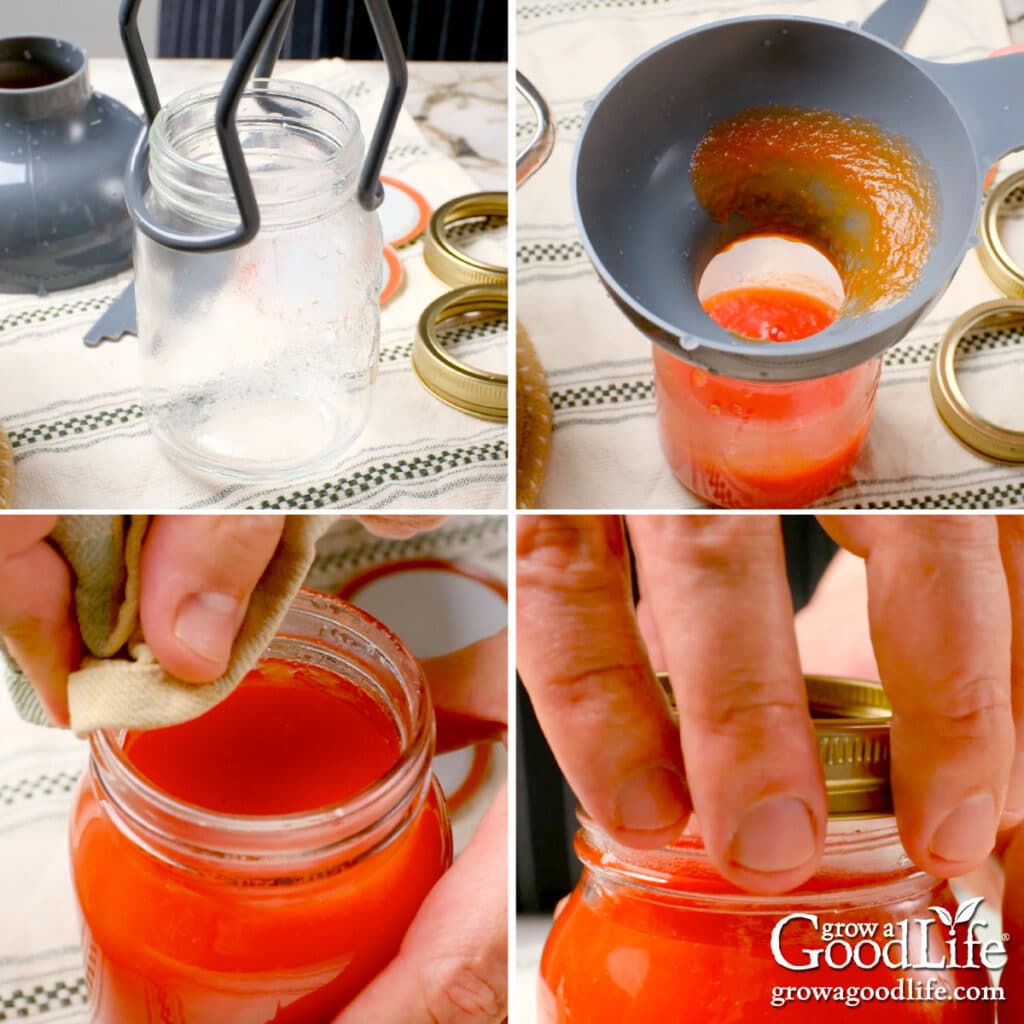
Step 6: Process in a Water Bath Canner
Boil the Jars: Once the filled jars are all in the canner, adjust the water level so it is at least 2 inches above the tops of the jars. Cover the pot and bring it to a boil over medium-high heat. Once the water boils vigorously, set a timer and process for the times indicated in the recipe below.
Cool the Jars: When the processing time is complete, turn off the heat, remove the lid, and let the canner cool and settle for about 5 minutes. Spread a dry kitchen towel on the counter. Use the jar lifter to remove the hot jars from the canner and place them on the towel. Keep the jars upright, and don’t tighten bands or check the seals yet. Let the jars sit undisturbed for 12 to 24 hours to cool.
Check the Seals: After 12 to 24 hours, check to ensure the lids are sealed by pressing on the center of each cover. Refrigerate any jars that failed to seal and consume within a week.
Store the Jars: Prepare your jars for storage by removing the ring bands and washing them thoroughly in warm, soapy water to eliminate residue. Dry the jars, then label and date them. Store in a cool, dark place between 50 and 70°F. For optimal flavor, use within 12 to 18 months. This recipe yields about 8 half pints, 4 pints, or 2 quarts, depending on how much you reduce your sauce.
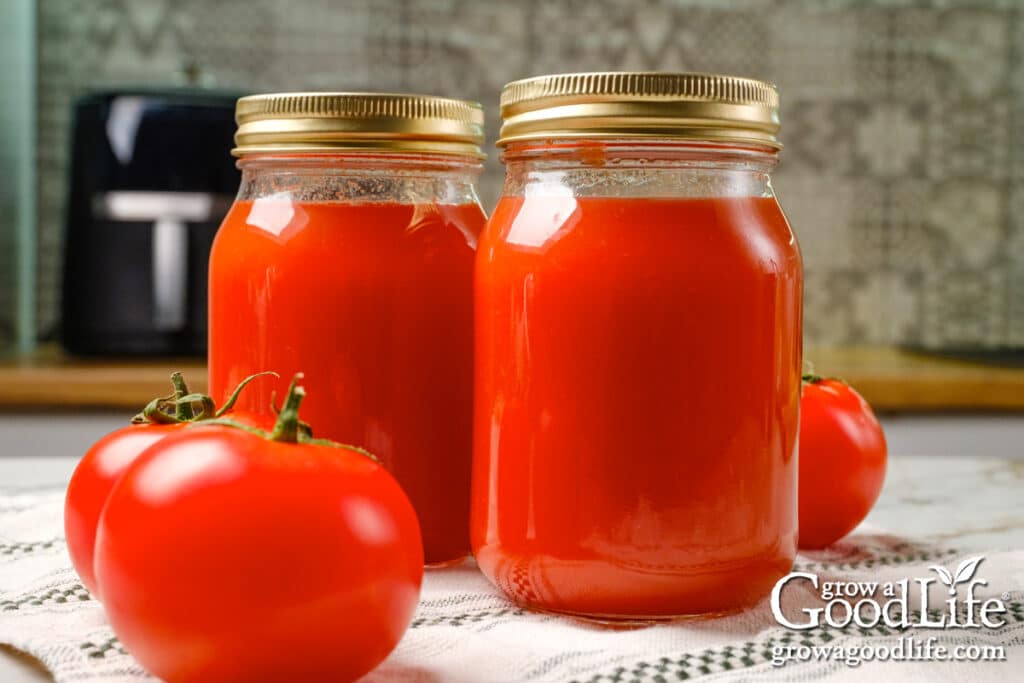
Ways to Use Tomato Sauce
Having jars of plain tomato sauce in your pantry gives you endless flexibility in the kitchen. Since this small-batch recipe is unseasoned, you can customize it to fit any meal or craving.
- Make quick pasta dinners: Warm the sauce, season to taste with salt, herbs, and garlic, and toss with your favorite pasta for a simple weeknight meal.
- Build a pizza base: Spread it on homemade or store-bought dough, add cheese and toppings, and bake for an easy pizza night.
- Use in soups and stews: Add depth and body to minestrone, chili, or vegetable soups by stirring in a jar of sauce.
- Create flavorful casseroles: Use as a base for baked ziti, lasagna, or stuffed peppers.
- Add to slow-cooked meals: Pour over meatballs, chicken, or beans in the slow cooker for easy, flavorful comfort food.
Tip: Keep a few jars in smaller half-pint sizes for recipes that need just a touch of tomato flavor without opening a full pint or quart.

Small Batch Tomato Sauce for Canning
Ingredients
- 10 to 15 pounds ripe tomatoes
- bottled lemon juice or citric acid
Instructions
Prepare the Tomatoes
- Wash the tomatoes well under running water. Remove the stems and cut a shallow “X” in the bottom of each fruit.
- Bring a large saucepan of water to a boil over high heat. As the water is heating, fill a large bowl with ice water.
- Once the water comes to a boil, dip your tomatoes into the boiling water until the skins crack and loosen, about 30 to 60 seconds.
- Transfer the tomatoes from the boiling water to the bowl of ice water to cool. Repeat for all the tomatoes.
- Once the tomatoes are cool enough to handle, remove the skins, scoop out the seeds, and cut out any thick cores.
- To remove the seeds: slice the tomato in half, hold each half over a bowl, and squeeze and scoop out the seeds with a spoon.
Make the Sauce
- Cut about 6 tomatoes into quarters, and place these in a large sauce pot.
- Bring to a boil over medium-high heat. Stir to prevent sticking, and crush the tomatoes with the back of your spoon once they soften.
- Cut the remaining tomatoes in half and add them to the pot as your work. Stir frequently to cook evenly and prevent sticking.
- When all the tomatoes have been added, continue to cook, stirring occasionally, until the tomatoes are soft and juicy, about 10 minutes.
- Remove the pot from the heat and let the tomatoes cool slightly before pureeing.
- Puree the tomatoes using a food processor, food mill, or sieve to smooth out the sauce.
- Return the tomato puree to the saucepot and simmer uncovered over medium-low heat for 1 to 2 hours until the sauce thickens and reduces in volume:• Reduce by 1/3 for a thin sauce. • Reduce by 1/2 for a thick sauce.
Prepare the Canner and Jars
- While the tomato sauce is cooking, wash the jars, lids, bands, and canning tools in warm, soapy water. Rinse thoroughly, and set aside to air dry on a clean kitchen towel.
- Place the water bath canner on the stove. Place the jar rack into the pot, set the jars in the canner, and fill with enough water to cover the jars.
- Bring the canner to a simmer (180˚F) for 10 minutes, and keep the jars hot until you are ready to fill them.
Fill the Jars
- Spread a kitchen towel on the counter. Use the jar lifter to remove ONE jar from the canner. Drain the water back into the canner, and place it on the towel. Keep the remaining jars in the canner so they stay hot.
- Measure and add citric acid or lemon juice to the jar: • Half-pint jar: Add 1/8 teaspoon citric acid or 1/2 tablespoon bottled lemon juice•Pint jar: Add 1/4 teaspoon citric acid or 1 tablespoon bottled lemon juice•Quart jar: Add 1/2 teaspoon citric acid or 2 tablespoons bottled lemon juice
- Use the canning funnel and ladle to fill the jar with the tomato sauce. Leave a 1/2-inch headspace.
- Run the bubble popper through slowly to release any air bubbles. Wipe the rim with a clean, damp towel to remove any residue.
- Add the lid and secure it with a screw band until it’s fingertip tight.
- Return the jar to the canner. Then, repeat with the rest of the jars.
Process in a Boiling Water Bath Canner
- Once the filled jars are all in the canner, adjust the water level so it is at least 2 inches above the tops of the jars.
- Cover your canner and bring it to a boil over medium-high heat. Once the water boils vigorously, set a timer and process half-pints and pints for 35 minutes, and quarts for 40 minutes at altitudes of less than 1,000 ft. Adjust processing time for your altitude if necessary. (See notes.)
Cool and Store
- When the processing time is complete, turn off the heat, remove the lid, and let the canner cool and settle for about 5 minutes.
- Spread a dry kitchen towel on the counter. Then, use the jar lifter to remove the hot jars from the canner and place them on the towel. Keep the jars upright, and don’t tighten bands or check the seals yet. Let the jars sit undisturbed for 12 to 24 hours to cool.
- After the jars have cooled for at least 12 hours, check to be sure the lids have sealed by pushing on the center of the lid. The lid should not pop up. If the lid flexes up and down, it did not seal. Refrigerate the jar and use it within a week.
- Remove the screw on bands and wash the jars to remove residue. Label, date, and store your jars in a cool, dark place. Use within 12 to 18 months for the best flavor. Refrigerate the sauce once opened and consume within a week.
- Yield: About 8 half pints, 4 pints, or 2 quarts, depending on how much you reduce your sauce.
Notes
- 1,001–3,000 feet: 40 minutes
- 3,001–6,000 feet: 45 minutes
- 6,001–8,000 feet: 50 minutes
- 8,001–10,000 feet: 55 minutes
- 1,001–3,000 feet: 45 minutes
- 3,001–6,000 feet: 50 minutes
- 6,001–8,000 feet: 55 minutes
- 8,001–10,000 feet: 60 minutes
Nutrition
This small-batch plain tomato sauce canning recipe is a simple and satisfying way to preserve your garden’s harvest. With just fresh tomatoes and a little time, you can stock your pantry with jars of pure, unseasoned tomato goodness ready to become pizza sauce, pasta sauce, soup base, or anything your kitchen creativity calls for.
If you enjoyed this recipe, you might also like these other tomato canning favorites:
- Seasoned Tomato Sauce Canning Recipe: A flavorful sauce simmered with onions, garlic, and herbs.
- Pizza Sauce: Oven-roasted tomatoes, onions, and garlic for a deep, rich flavor.
- Oven-Roasted Tomato Sauce: A classic Italian-style sauce featuring fresh basil and generous amounts of garlic.
Canning tomato sauce at home is one of the most rewarding ways to capture the essence of summer. Each jar you tuck away now becomes a taste of sunshine waiting for you all winter long.
